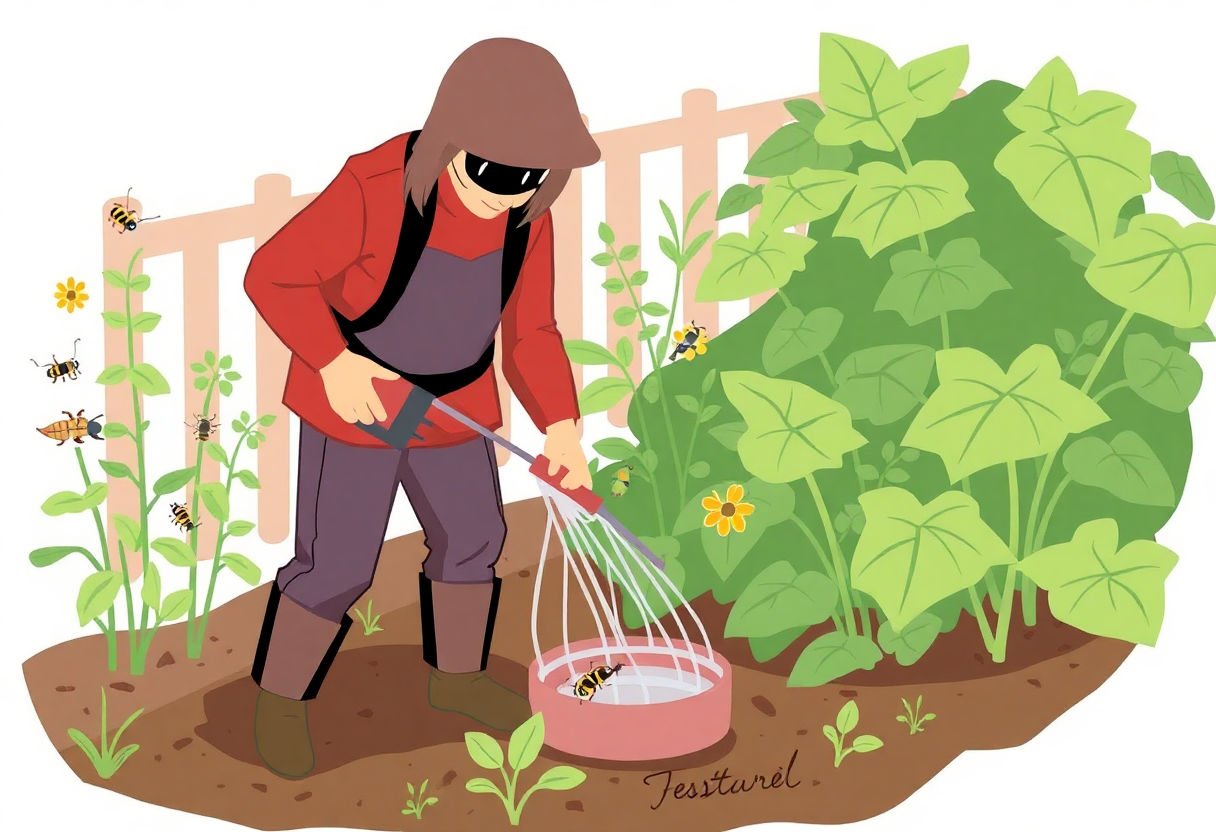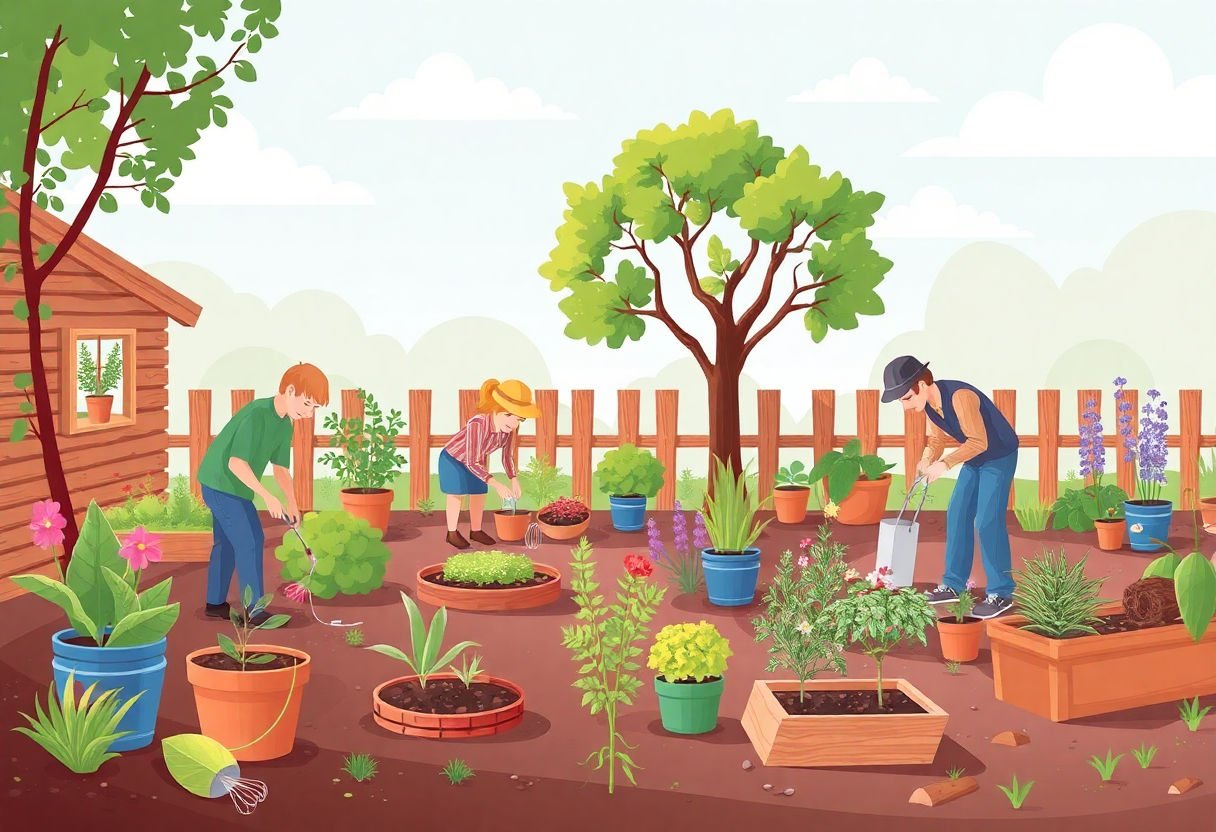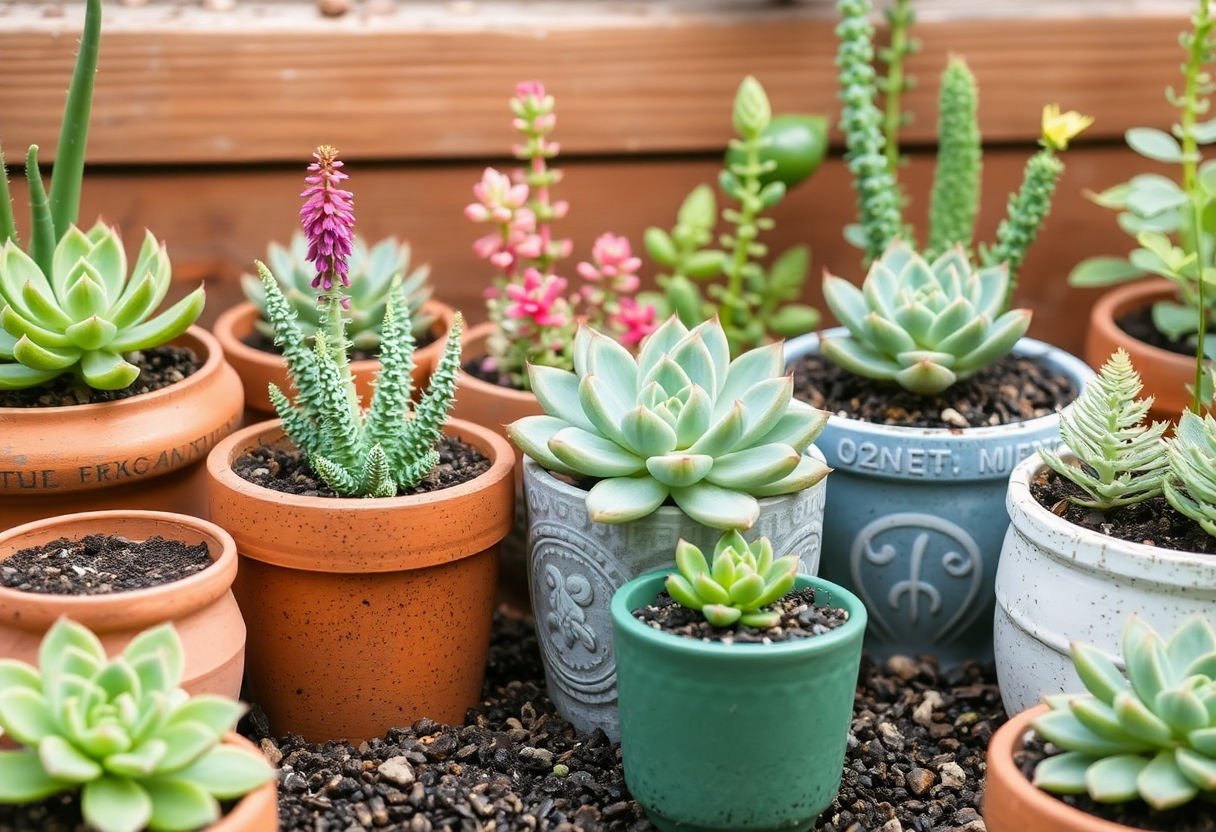Caring for succulents can be both rewarding and eco-friendly. More than just décor, these resilient plants thrive with sustainable choices. Embrace eco-friendly practices to boost plant health and help our planet. Consider sustainable potting soil, recycled materials, and alternatives to plastic. Engage in water-saving tips and natural pest control. Start today, and transform your garden into a green sanctuary that thrives and respects nature. Let’s explore practical steps for a more sustainable garden. This journey not only supports your succulents but also nurtures the earth. From soil to pots, every choice counts.
Key Takeaways
- Choose sustainable materials like recycled or biodegradable pots to reduce environmental impact.
- Opt for eco-friendly potting soil to enhance succulent health and promote sustainability.
- Explore alternatives to plastic pots that maintain style and functionality.
- Implement water-saving techniques to support plant growth and conserve resources.
- Engage in community gardening projects to support local eco-friendly initiatives.
The Importance of Eco-Friendly Gardening

Gardening changes when you switch to eco-friendly methods. Traditional gardening may add to pollution and waste. Think of using chemicals that hurt not just pests but also good insects. Eco-friendly gardening helps the earth. You can help by choosing better ways.
Using natural compost makes a big difference. Compost enriches the soil without harming it. Unlike synthetic fertilizers, it boosts soil health in the right way. It is like giving your plants a natural power-up.
Watering plants the right way can save this valuable resource. Drip systems and rain barrels can help. They use less water than sprinklers. Every drop counts.
Biodegradable pots are useful. Traditional plastic pots break down slowly and harm the planet. Try pots made from coconut husks or recycled paper. These materials keep your plants safe and do no harm to the earth.
Incorporating eco-friendly practices benefits you and the environment. Your garden thrives, and you contribute to a healthier world. Eco-friendly gardening is more than a trend. It is a choice for a better future.
Remember, every small change matters. Start with one step towards a greener garden. Choosing eco-friendly options sets a good example. You help build a sustainable planet.
Choosing the Right Potting Soil
Choosing the right potting soil for succulents plays a big role in their health. Succulents thrive in soil that drains quickly and does not retain too much water. This type of soil prevents root rot, which can hurt the plants.
Look for soil mixes labeled specifically for succulents or cacti. These mixes often contain a mix of materials like sand, perlite, and pumice. Sand makes the soil gritty, which helps with drainage. Perlite and pumice, while lighter, create space in the soil for air, preventing water from sitting too long.
- Sand: Adds grit and improves drainage.
- Perlite: Made from volcanic glass, keeps soil airy.
- Pumice: Another volcanic rock that enhances drainage.
Consider eco-friendly soil options. Some products use sustainable materials like coconut coir. Coir is a byproduct of the coconut industry. It retains moisture but dries out quickly, which is good for succulents.
For a DIY approach, mix your own potting soil. Combine two parts of sand, two parts of potting soil, and one part of perlite or pumice. This mix supports plant health while using easy-to-find materials.
When choosing potting soil, remember: not too rich, not too compact. The right mix supports succulent growth and helps protect the environment.
Recycled and Biodegradable Pot Materials
Recycled and biodegradable pots offer a green choice for your succulent garden. These materials help reduce waste and protect the earth. Recycled pots often use old plastics or metals. By using them, you give these materials a new life. Each time you choose a recycled pot, you help save resources.
Biodegradable pots stand out because they break down naturally. Over time, they return to the earth. These pots can use materials like cardboard, coir, or peat. Imagine a pot that decomposes, leaving nothing behind. It’s a simple step to cut down on waste.
Both recycled and biodegradable materials come in different shapes and sizes. Whether you like a simple style or a bold look, you will find a pot that fits. They work well both indoors and outdoors, offering flexibility in your plant setup.
Benefits of these materials include:
- Reduced Waste: Less trash in landfills.
- Resource Conservation: Save natural resources by reusing existing materials.
- Sustainability: Foster a cycle that supports nature.
By selecting recycled or biodegradable pots, you make a small but important change. It’s a choice that helps both your garden and the planet. So, as you plan your succulent garden, think about giving these eco-friendly pots a try.
Alternatives to Plastic Pots
When you look for alternatives to plastic pots for your succulents, consider options that are kind to the planet. There are many choices that look great and support a healthy environment.
Clay or Terracotta Pots
Clay pots breathe. This helps air reach the plant roots. They give a rustic look to any garden. These pots may dry out faster, but succulents thrive with less water.
Wooden Containers
Wooden pots add a natural touch. You can use reclaimed wood for a unique look. Make sure the wood is treated to avoid rot. These containers often provide good insulation, keeping plant roots cool.
Bamboo Pots
Bamboo grows quickly and is easy to replace. Pots made from bamboo are strong and lightweight. They break down in nature without harming it.
Metal Planters
Metal pots, like those made of stainless steel, give a modern look. They last long and can be recycled. Be gentle with watering as metal may heat up in the sun.
Fabric Grow Bags
Fabric bags, made from recycled materials, allow air to flow. They adjust like a soft chair for roots, promoting healthy growth. You can easily move them around because they are light.
These choices offer style without plastic. Each has its own benefits depending on your needs. Find the one that fits your garden the best and enjoy a more eco-friendly space.
DIY Sustainable Potting Ideas

Creating your own eco-friendly pots at home can be fun and kind to the planet. You can use everyday items and natural materials to craft unique plant homes. Here are some ideas:
-
Tin Cans: Save tin cans from the kitchen. Clean them, remove the labels, and you’re set. Decorate them with paint if you like. They provide a sturdy home for your succulents. Remember to poke holes in the bottom for drainage.
-
Coconut Shells: Use half coconut shells after you enjoy the fruit. They offer a natural look and are biodegradable. Drill a small hole for water drainage.
-
Glass Jars: Repurpose old glass jars. Fill the bottom with pebbles for drainage, then add soil. Glass jars make great windowsill planters.
-
Old Boots: An old pair of boots can become quirky pots. They add personality to a garden corner. Drill small holes in the soles for water to escape.
-
Eggshells: Grow tiny succulents in eggshell halves. Place them in an egg carton for stability. These make great starter pots and enrich the soil when you eventually plant the succulents outside.
With these ideas, you reduce waste and create charming plant displays. Plus, each pot tells its own story. Enjoy getting creative!
Water Conservation Techniques
Succulents do well in dry environments. They don’t need much water, which is a good starting point for conservation. But how can we make sure they thrive with even less?
First, water deeply but not often. This means soaking the soil and then letting it dry completely. This encourages roots to grow deeper, making plants stronger in dry times.
Next, use a drip system if possible. Drip systems give water directly to the roots slowly. This reduces wastage as there is no runoff or evaporation.
Mulching helps too. Mulch is a layer of material on the soil. It keeps the soil cool and moist. Use pebbles or small stones for succulents to match their natural habitat.
Collecting rainwater can save gallons. Set a barrel outside to catch rain. Then, use it to water your garden later. It’s a simple and effective method.
Lastly, check the weather. Water when it’s cooler, like early morning or late afternoon. This slows evaporation and keeps soil wet longer.
By practicing these steps, you save water and help the environment. Try these today to create a thriving and sustainable garden.
Natural Pest Control Methods

Natural Methods to Keep Pests Away
Succulents need protection from pests. Chemical sprays often harm the environment. Use natural methods instead. These are safe and work well.
Neem Oil
Neem oil acts like a shield. It stops insects from munching on plants. Mix a teaspoon of oil with a quart of water. Spray plants every week.
Garlic Spray
Garlic has a strong smell. It keeps bugs away. Crush a few garlic cloves. Soak them in water overnight. Strain and spray on leaves.
Essential Oils
Certain scents drive pests away. Use peppermint or lavender oil. Add a few drops to water. Spray around your garden. Bugs will steer clear.
Soap and Water
Soap can break down insects’ outer shells. Use mild soap and water. Spray where pests gather. Soap dries them out and keeps your plants safe.
Companion Planting
Some plants deter pests. Lavender or marigold can be helpful. Plant them close to succulents. These plants will act like natural bodyguards.
Handpicking
Inspect your garden often. Remove pests by hand. This simple step can prevent a big infestation.
Regular checks and natural treatments build a healthy garden. Your succulents will thrive without harm to nature.
Sourcing Eco-Friendly Supplies

When starting a garden with eco-friendly goals, finding the right supplies makes a big difference. Look for organic soil. It avoids chemicals and keeps the earth healthy. Compost stores often carry this type. For tools, check out items made from bamboo or wood. They last long and aren’t harsh on the planet.
Online stores include sections for green choices. Websites like EcoGarden and EarthHero often have what you need. Local nurseries might also have eco-friendly sections, giving you a chance to ask about sustainable options.
Recycled pots are a great choice. Some brands offer pots made from old tires or yogurt cartons. These not only cut waste, but they give old materials a new life. When looking for seeds, pick organic varieties. Such seeds grow without harsh treatments and support a healthier ecosystem.
Here’s a list to guide you:
- Organic Soil: Free from chemicals, boosts plant health.
- Bamboo or Wood Tools: Sustainable and durable.
- Recycled Pots: Made from reused materials.
- Organic Seeds: Grown naturally.
Finding eco-friendly supplies might seem tricky, but resources are out there. Look locally, go online, and ask questions. You’ll gradually build a garden that’s both beautiful and kind to the earth.
Engaging in Community Gardening Initiatives

Join a community gardening project and make a difference. These projects bring people together to grow plants and care for the earth. Community gardens offer a perfect chance to get involved in local eco-friendly initiatives.
Benefits of Community Gardening:
- Shared Resources: Get access to tools and materials you may not own.
- Learning Opportunities: Gain gardening tips from experienced members.
- Social Interaction: Meet others who share your passion for plants.
- Improved Well-being: Gardening can improve mood and reduce stress.
How to Get Involved:
- Find a Local Group: Search online or ask local councils about nearby community gardens.
- Visit and Volunteer: Spend a day at the garden to see if it suits you.
- Participate in Workshops: Many gardens hold themed events and workshops.
- Bring Ideas: Share your thoughts on sustainable gardening with the group.
With community gardening, you can boost your gardening skills. You contribute to the environment and enjoy fresh air and friendship. Plus, you help create greener spaces in your area. Whether potting succulents or planting vegetables, every effort counts. Join a community garden today and grow something great with others!
Conclusion
Choosing eco-friendly potting options creates a positive impact on your succulent garden and the environment. Sustainable materials and practices not only improve the health of your plants but also help protect our planet. By using recycled pots, biodegradable materials, and natural pest control methods, you make a difference. These small changes can lead to bigger environmental benefits over time. So, embrace these green choices in your gardening. Your succulents will thrive, and you contribute to a healthier earth for everyone. Let’s nurture our gardens and the world at the same time.
Frequently Asked Questions
What are the benefits of using eco-friendly potting materials for succulents?
Eco-friendly materials reduce waste and help keep the planet clean. They also support healthy plant growth. Natural options often provide better drainage and aeration.
How can I tell if a pot is biodegradable?
Biodegradable pots break down naturally over time. Look for labels that say “compostable” or “biodegradable.” They often feel less rigid than regular plastic pots.
Are recycled pots durable for outdoor use?
Yes, many recycled pots are quite sturdy. They last through rain and sun. Check for UV-resistant options for extra durability.
Can I create my own pots using household items?
Yes, you can. Old containers like cans or jars can become plant pots. Make sure they have drainage holes and are clean before use.
Do eco-friendly pots require special care for succulents?
Not really. Just ensure proper drainage to avoid waterlogging. Regular pot care or cleaning helps maintain plant health.
